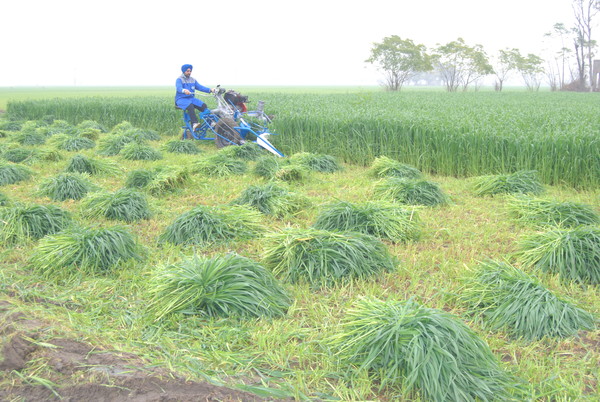
Bioeconomy challenges climate change
During the recent COP 23, special attention was paid to bioeconomy as a key strategy to fight global warming. High-level ministers and representatives of member – countries of the "Biofuture Platform" – also joined by Italy and India – have signed a declaration of intent to support the sustainable development of bioproducts and bioenergy. Investing in renewable sources is the challenge for the decarbonization of future economy
The 23rd UN Bonn Climate Conference (COP 23), held in November, did not give an impetus that is comparable with that created in Paris a couple of years ago. In fact, the positions of the European governments still appeared extremely weak. The US failed, while the developing countries expressed concerns about the expected use of economic resources ($100 billion) that they should receive to cope with climate change (defense from extreme weather events, rising of sea levels, and advancing desertification). However, although many participants perceived a limited degree of concreteness in policy positions, a good result has been achieved on the path towards the process of decarbonization, also thanks to the strong market position gained by the renewable energy sources. A glaring example is provided by what happened in the US when President Trump gave the mandate to review the ”Clean Energy Plan,” implemented by his predecessor Obama. Despite this fact, nearly $30 billion has been investedin renewable sources. Over the past few years, more than half of the US coal-fired power plants have closed, and many others are about to do the same. Some strong economic realities – such as California or New York City – continue to meet the commitment made to reduce emissions with programmes to support the development of renewable sources. In India, according to data released by the Ministry of Renewable Energy, in only 12 months (April 2016-March 2017) renewable energy plants were installed for an electrical power of 11 GW against 6.7 GW from conventional energy sources. For the first time in the history of this populous country, the surplus of investments in clean energy has overtakenthe level of investment in fossil energy. Also, an impressive share (around 70%) of India’s energy consumption still derives from coal, but pollution emergency has led to a decree on the ban on new coal-fired power stations starting from 2022, questioning investments already planned. For the same year, an increased target of 175 GW of renewable energy sources has been set by installing: 100 GW of solar power, 60 GW of wind power, 10 GW of bioenergy, and 5 GW of hydroelectric power. Finally, in Italy, the recent National Energy Strategy has established to divest all the coal-fired power plants by 2025. All these examplesand many others could lead to an emerging, global-scale approach to countering overheating of the planet. Generally speaking, COP 23 in Bonn was not a mere ceremony of eco-diplomacy, as the negotiations have continued and through the dialogue between the parties many drafts of documents have been finally defined.One of the most relevant drafts concerns Bioeconomy. High-level representatives and member-countries of the ”Biofuture Platform” (also joined by Italy and India), such as Argentina, Brazil, Canada, China, Denmark, Egypt, Finland, France, Indonesia, Morocco, Mozambico, Holland, Paraguay, Philippines, Sweden, Great Britain, and Uruguay have defined a strategic vision of bioeconomy to counteract air pollution and climate change.The bioeconomy sector is not a limited market niche. It is a large and varied set of economic activities which, from renewable biological resources, can have exceptional outlets in sectors such as energy, biomaterials, green chemistry, etc. Of course, all these production chains must be based on sustainable practices driven by scientific research, technological innovation, and many other well-established good practices.With these assumptions, the desired growth of bioeconomy, in addition to the respect for biodiversity, can also produce great environmental, social and economic benefits by replacing fossil raw materials, creating new jobs, and promoting territorial development. A clever management of residual biomass from agriculture and forests can generate a huge flow of valuable resources to feed low-impact production cycles. Every year, crops, forests, and marine organisms capture several hundred billion (about 250) tons of atmospheric CO2 in biomass from which it is possible to obtain high-added value products. Despite the establishment of a widespread social and entrepreneurial consensus on bioenergy and bioproducts, their trend of growth (except a few countries and sectors) is out of step with its development potential and the environmental urgency that has to be faced. Investments are slowed down by political and financial obstacles that could be removed by implementing some points in the document. Some of these points are listed below: removal of subsidies for the production and use of fossil fuels; introduction of a carbon tax and incentives for bioenergy and bioproducts within a circular economy; creation of integrated value chains linking a wide range of industries, biomass farmers’ organizations, and end-users of bioproducts and bioenergy; implementation of smart agricultural policies to promote a more rational use of resources; restoration of degraded lands and biodiversity protection, with the consequent reduction of waste and residue valorization; strengthening support to research and innovation alongside the transfer of knowledge on a global level.
From the list of things to do, it is clear that the path to follow is long and difficult, but the positive effects justify the necessary efforts. For this reason, creating the conditions to support a low-carbon bioeconomy is an urgent and vital challenge for the destiny of the Planet.








